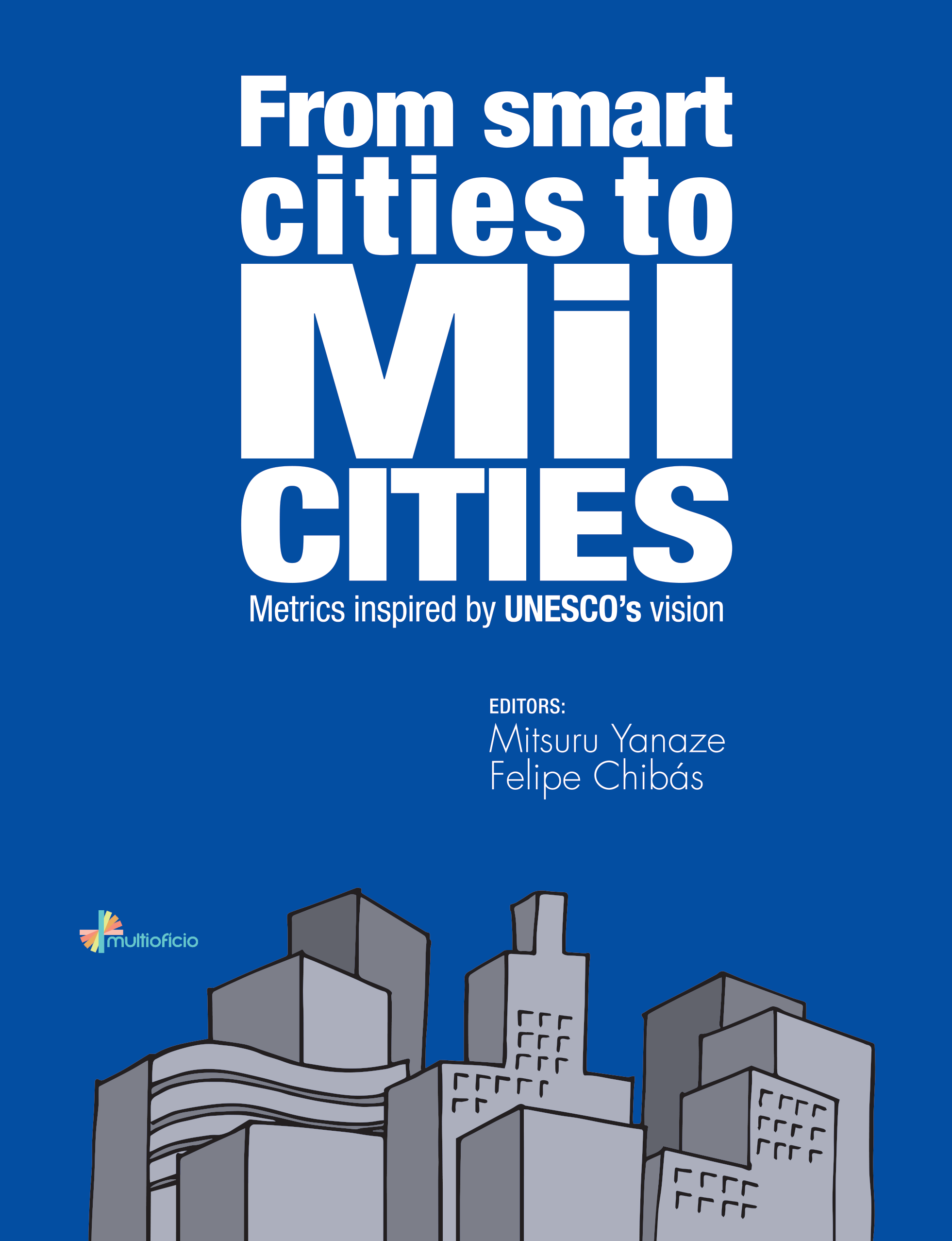
This new book was published in 2020 by CEACOM of the University of São Paulo with the support of UNESCO-GAPMIL. It addresses the concept of MIL Cities defended by UNESCO. It has authors and experts from 14 countries of this entity, as well as renowned researchers, market professionals and activists.

Center for Evaluation and Measurement Studies in Communication and Marketing - ECA/USP

Global Alliance for Media and Information Literacy Partnerships
Main concepts
Virtual Reality version
Based on the concepts presented, Prof. PhD. Heliodoro Bastos, renowned catunist known as Dorinho, wrote a chapter of the book filled with cartoons that provoke reflection on the MIL Cities. From this chapter, Prof. PhD. Leandro Yanaze, author of another chapter of the book, proposed the creation of an environment in Virtual Reality to promote immersion in those cartoons. See the result:
MIL CITIES IN VIRTUAL REALITYProfessors
Prof. PhD. Mitsuru H. Yanaze

Prof. PhD. Mitsuru H. Yanaze
Full Professor of the School of Communications and Arts (ECA) of the University of São Paulo (USP) and CEACOM Coordinator, trainer of generations of professionals and author of bestselling books in the marketing area. Book editor.
Prof. PhD. Felipe Chibás Ortiz

Prof. PhD. Felipe Chibás Ortiz
Associated Professor, UNESCO Representative for Latin America and the Caribbean at UNESCO GAPMIL, member of CEACOM, author of numerous books on Innovation, Marketing, etc. Book editor.
Prof. PhD. Dorinho Bastos

Prof. PhD. Dorinho Bastos
Associated Professor at CEACOM at the School of Communications and Arts (ECA) at the University of São Paulo (USP) and renowned cartoonist. Cover and chapter author in this book.
Prof. PhD. Leandro K. H. Yanaze

Prof. PhD. Leandro K. H. Yanaze
Professor Doctor at the Federal University of São Paulo (UNIFESP). Author of several books on digital communication. Chapter author in this book and developer of the Virtual Reality version.
Authors
| Foreword | Anton Grizzle |
| Preface | Jesus Lau (GAPMIL – UNESCO) |
| Introduction | Mitsuru Yanaze, Felipe Chibás Ortiz (CEACOM/USP) |
| Preliminary Note | Felipe Chibás Ortiz (UNESCO Representative for Latin America at UNESCO GAPMIL) |
| 0. MIL Cities Metrics and Artificial Intelligence under UNESCO perspective: São Paulo case | Felipe Chibás Ortiz, Alton Grizzle, Aline M. Borges, Flávia Rudge Ramos, Barbara Mazzetti e Orlando da Silva Junior (Cuba, Jamaica, Brazil) |
| 1.1. Libraries as learning and empowering bridges for MIL Cities | Estrella Luna Muñoz (México) |
| 1.2. Harnessing the Power of Libraries in Nairobi to become Media and Information Literacy Learning Centres | Wallace Gichunge (Kenya) |
| 2.1. The Best Place in the World: Modeling the Neighborhood | Howard Blumenthal (United States) |
| 2.2. Transit Digital Art Lab: A Case Study | Paul Guzzardo (United States) |
| 3.1. Roll of City hall, Public Institutions and Citizens to build MIL cities | Maja Zaric (Serbia) |
| 3.2. Launching MIL Projects in Hong Kong under the Smart City Blueprint | Alice Y. L.Lee (China) |
| 3.3. Public Communication as an intersection for the construction of a MIL City concept: the São Paulo City Hall | Simone Denise Gardinali Navacinsk e Elaine Cristina Gardinali (Brazil) |
| 4.1. Health Institutions have Preventive Health Information like Mil Cities: Metrics and Actions | Milouda Boichou (Marrocco) |
| 5.1. - Informational Media Literacy in the city of São Paulo: a new look at Culture, Art, Leisure, Sport and Tourism | Davi Mayer (Brazil) |
| 6.1. MIL Cities and the role of African Universities: Observing the relevance of Information Ethics programmes in six African countries | Rachel Fischer e Coetzee Bester (South Africa) |
| 6.2. Media and Information Literacy in the Higher Education System on the Post-soviet Space: Potential and Development Prospects | Irina Zhilavskaya (Russia) |
| 6.3. University cities as MIL cities: Case Study of FACENS University Center | Regiane Relva Romano (Brazil) |
| 6.4. Pedagogical trails for citizenship in the development of MIL Cities | Leandro Key Higuchi Yanaze, Edna de Mello Silva, Yohhan dos Santos Ribeiro, Andreia Neves Asami (Brazil) |
| 7.1. Technological and Cultural dimensions of a safe MIL city | Giovanna Gianturco e Mariella Nascenzi (Italy) |
| 8.1. Fake News and Media Literacy in Jamaica: The Influence of the Broadcasting Commission as a Component of a Global MIL City | Jeffery Deans (Jamaica) |
| 9.1. Artificial Intelligence, Startups and Digital Channels: Inclusion, Efficiency and Quality in Service to Organizations in MIL Cities | Rúbia Steiner (Brazil) |
| 10.1. Security within MIL cities: how the citizen-reporter relationship plays na essential role in Journalism | Rachel Schnalzer (United States) |
| 11.1. Creating a SMILE centre in Tunis: MIL, Governance and Sustainability | Divina Frau-Meigs (France) |
| 11.2. Strengthening data and Information Literacy for Inclusive, Safe, Resilient and Sustainable Cities in the Global South (focus on India and Africa) | Jagtar Signh e Kiran Pandey (India) |
| 12.1. More Women in Politics: a challenge for the MIL Cities | Wania Torres (Brazil) |
| 13.1 Integrated Communication Objectives and Goals for Wise Cities / MIL (Wise and Media and Information Literacy Cities) | Mitsuru Yanaze (Brazil) e Felipe Chibás (Cuba/Brazil) |
| 13.2. From Smart cities to MIL cities: Integrating Media, Information and Digital Literacy in City Plans for Sustainable Smart Cities | Jude Chukwunonso Abugu (Nigeria) |
| 13.3. - La Habana from 500 to MIL: contributions from urban anthropology | Avelino Víctor Couceiro Rodríguez (Cuba) |
| 13.4. The MIL Cities: a Look at Cartoons | Dorinho Bastos (Brazil) |